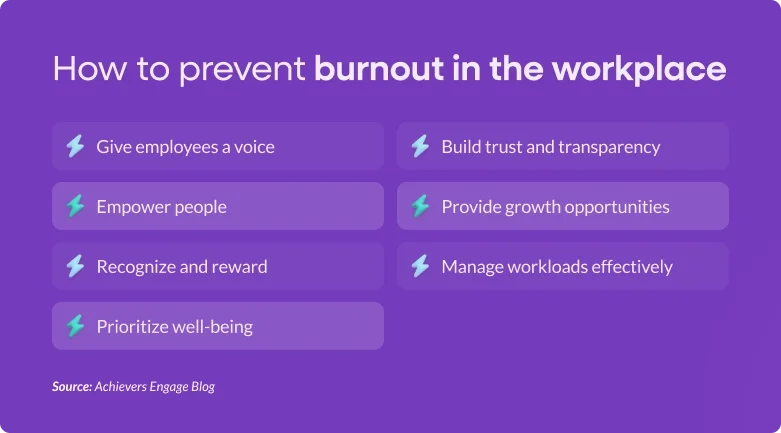Table of contents
Burnout is a real concern affecting employees and organizations globally. Insights from SHRM’s 2024 Research Series found 44% of employees feel burned out at work. Left unchecked, burnout drains motivation, reduces productivity, and leads to disengagement and turnover.
But burnout isn’t inevitable. When employees feel valued, supported, and recognized, they’re far more likely to stay engaged and ready to put their best foot forward. That’s why companies need to go beyond just acknowledging burnout — they need to actively prevent it.
In this guide, we break down the key signs and causes of burnout, with actionable strategies to build a culture where employees feel appreciated, empowered, and motivated to do their best work.
What is burnout?
Burnout is a state of feeling mentally, emotionally, and physically drained from constant stress or overwork. Burnout can affect anyone, regardless of age, gender, lifestyle, or career and, while it’s not permanent, it can negatively impact physical and mental well-being if left untreated.
Signs and causes of burnout in the workplace
Before you can address or even prevent burnout, you need to recognize the warning signs and understand what drives it. Those insights can help you approach your team with greater understanding and compassion.
Signs of burnout
- Disengagement: Employees seem checked out, less involved, or uninterested in their work.
- Decreased productivity: Work slows down, and it takes more effort to get things done.
- Increased mistakes: Sloppy errors and missed details become more common.
- Frequent absence: More sick days and last-minute time off signal deeper issues.
- Irritability: Stress makes small frustrations feel bigger, leading to short tempers.
Causes of burnout
- Excessive workload: Unrealistic demands leave employees overwhelmed and exhausted.
- Lack of autonomy: Employees feel powerless to make decisions or control their work.
- Rigid structure and policies: Strict rules make it harder to work efficiently.
- Lack of leadership support: Employees feel unheard, undervalued, or unappreciated.
- Poor work-life balance: Long hours and constant pressure make it hard to recharge.

7 examples of how to prevent burnout in the workplace
Burnout doesn’t just affect employees — it impacts organizations as a whole. When people feel exhausted, overwhelmed, and stressed at their job, they don’t produce their best work, and the entire company feels the impact.
But a company culture that prioritizes employee well-being leads to higher performance, stronger retention, and a happier, healthier workforce. Protecting employees isn’t just the right thing to do — it’s good for business.
Here’s how you can steps to prevent burnout in the workplace:
1. Give employees a voice
- Create open channels for feedback: When employees feel heard, they feel valued. Encourage frequent communication through anonymous surveys and other employee feedback tools, giving them a safe space to address concerns without fear of judgment or punishment.
- Encourage transparency: Keep employees informed and up to date with what’s happening in the organization. Regular communication ensures there’s no ambiguity, which can lead to frustration and anxiety.
- Act on feedback: Acting on feedback shows employees their voice matters and shows your commitment to fostering a healthier culture.
2. Empower people
- Provide autonomy in roles: Many employees find motivation through autonomy at work. Give your people the freedom to make decisions and take ownership of their work.
- Encourage skill development: Growth and development are essential to workplace engagement and morale. Offering development opportunities is one of the best ways to show you’re invested in their success.
- Offer flexible work options: Flexibility is a key driver of stress and work-life balance. Give employees control over where and how they work, whether they thrive in a remote work environment or prefer the hybrid model.
3. Recognize and reward efforts
- Frequent recognition: Burnout is often a result of feeling unseen and undervalued at work; but meaningful, monthly recognition can double engagement, productivity, and belonging.
- Personalized rewards: The rewards you offer should reflect the uniqueness of your team. Whether it’s a gift card, a charitable donation, or an experience, personalized rewards show you care about your employees for the individuals they are.
- Peer-to-peer recognition: Recognition shouldn’t just come from the top-down. Encouraging colleagues to recognize one another’s achievements and contributions creates a culture of mutual respect and keeps engagement high.
4. Prioritize well-being
- Promote work-life balance: Encourage employees to set boundaries and unplug after work. Lead by example by refraining from late-night e-mails or weekend messages. Respecting work-life balance helps employees recharge and stay engaged.
- Offer wellness programs: Provide access to mental health resources, fitness incentives, and stress management tools. Consider offering employee resource groups (ERGs), gym membership, or meditation apps. Investing in employee well-being shows that the company values them beyond their performance at work.
- Create a supportive environment: Create an environment where employees feel safe to voice concerns, discuss the barriers to their work, or ask tough questions. A supportive workplace is the foundation of a healthy culture and long-term success.
5. Build trust across the organization
- Foster open communication: Encourage open and honest conversations between team members and leadership – whether through one-on-one meetings, employee surveys, or town halls. Employees should feel comfortable voicing their opinion without fear of judgment or punishment.
- Be transparent with decision-making: Explain the reasoning behind company decisions, especially when they affect employees directly. Even if employees don’t fully agree, they’ll appreciate the honesty and feel more included in the process.
- Show empathy and support: Managers should regularly check in on employees, not just about work but also about how they’re doing personally. A simple “How are you feeling?” or “Is there anything I can do to support you?” can make a significant difference in preventing burnout.
6. Provide career growth opportunities
- Clear pathways for advancement: When employees feel stuck, disengagement and burnout follow. Provide career roadmaps, training programs, and mentorship to help employees see their future at the organization.
- Support mentorship programs: Mentorship programs create a sense of belonging and help employees navigate challenges with confidence. Connect employees with mentors who can offer guidance, career advice, and support.
7. Manage workloads effectively
- Set realistic expectations: Ensure employees have achievable goals and deadlines. Managers should regularly assess how workloads are divided to prevent employees from feeling overwhelmed.
- Prioritize tasks: Help employees focus on high-impact work rather than juggling too many low-priority tasks. Clear prioritization prevents employees from feeling like they’re constantly racing against the clock.
- Provide support during peak periods: When workloads increase, offer added resources, extend deadlines where possible, or bring in temporary support. A little extra help during busy times prevents burnout and keeps teams functioning at their best.
The importance of recognition in preventing burnout
Burnout often stems from feeling undervalued and unseen. When employees put in effort without acknowledgment, motivation dwindles, and stress rises. But consistent, meaningful recognition can make all the difference. Here’s why recognition is key:
- Boosts morale and well-being: Feeling appreciated reinforces a sense of purpose, reducing stress and emotional exhaustion.
- Increases engagement: Recognized employees are more invested in their work and the company’s success.
- Strengthens motivation: When hard work is acknowledged, employees feel encouraged to keep giving their best.
- Fosters connection: Regular recognition builds a culture of appreciation, making employees feel more supported.
- Reduces turnover: Employees who feel valued are less likely to leave, improving retention and team stability.
- Drives performance: Appreciation fuels productivity, helping employees stay focused and energized.
Workplace burnout: The hardest-hit industries
Burnout is a workplace issue that affects nearly every industry. However, varying demands, work environments, and expectations contribute to burnout at different rates. Understanding how burnout affects today’s biggest industries can help shed light on the issue and offer context to employers looking to address it within their organizations.
Healthcare
Healthcare is one of the highest-affected industries of workplace burnout. Staffing and resource shortages, administrative stresses, and lack of organizational support are just some of the reasons employees in this industry experience burnout. While doctor burnout dropped below 50% in 2024, there is still work to be done to ensure healthcare workers at all levels are able to feel supported and valued.
Manufacturing
Manufacturing is an industry known for intense workloads and production timelines; putting pressure on workers and managers to meet extreme deadlines and targets regularly. Because of this pressure, employees often work longer hours to keep up with the demand. Cultural improvements, managerial support, and psychological safety at work are all key to addressing and preventing burnout in the future.
Professional services
Professional services — firms that provide specialized services like accounting and marketing — often face chronic work-related stress that can lead to burnout. High-pressure environments, tight turnarounds, and poor work-life balance are common factors contributing to this growing workplace concern.
Finance and insurance
The insurance and finance sectors are each known for their high-stress environments, complex workloads, and monotonous tasks. These factors all contribute to physical and mental exhaustion, with the growing need for greater resources, technology, and management support to reduce the pressure on employees to meet growing expectations.
Making recognition effortless and impactful with Achievers
Preventing burnout starts with making employees feel valued, supported, and motivated. Achievers makes that easy by embedding recognition into everyday work, so appreciation becomes a natural part of your culture.
- Recognition in the flow of work: With integrations in the tools employees already use, appreciation becomes effortless and consistent.
- Encouraging the right behaviors: AI-powered insights help uncover and reinforce positive actions that contribute to well-being and engagement.
- Boosting resilience through appreciation: Employees who feel recognized are more likely to stay engaged, productive, and emotionally invested in their work.
- Personalized rewards for meaningful impact: A global rewards marketplace ensures employees receive recognition that truly resonates, making appreciation more impactful.
- A proactive approach to well-being: Research-backed strategies and expert support help organizations build a culture that prioritizes employee health, happiness, and retention.
With Achievers, recognition isn’t just a one-time initiative; it’s a powerful tool to reduce stress, strengthen engagement, and create a workplace where employees can be their best selves.
Fight burnout with a culture of recognition
Burnout isn’t an individual issue. It’s a workplace issue that affects productivity, morale, and engagement. As demands and expectations rise, employees need more than just workloads and deadlines; they need to know their efforts matter. The good news? Recognition is one of the most effective ways to combat burnout and build a thriving workforce.
Consistent, meaningful recognition creates a culture where employees feel seen, valued, and motivated to do their best work. It reinforces the behaviors that drive success and reminds employees that what they do makes a difference. With Achievers’ recognition platform, appreciating your employees becomes effortless — integrated seamlessly into daily workflows so appreciation is frequent, visible, and impactful.
The best-run businesses don’t just respond to burnout — they prevent it. Let Achievers help you create a culture that puts its people first, giving them the tools and support they need to create the best work of their lives.



